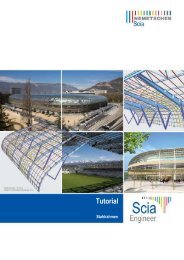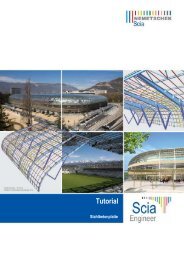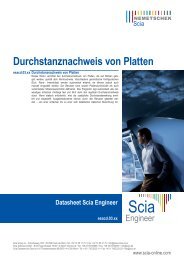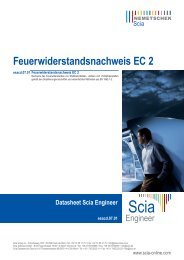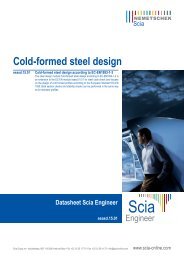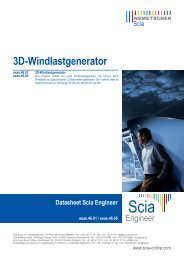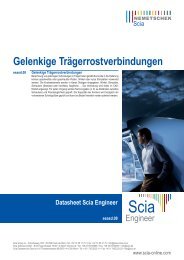Advanced Package Training Scaffolding 2011.1 - Scia-Software GbR
Advanced Package Training Scaffolding 2011.1 - Scia-Software GbR
Advanced Package Training Scaffolding 2011.1 - Scia-Software GbR
Create successful ePaper yourself
Turn your PDF publications into a flip-book with our unique Google optimized e-Paper software.
20<br />
<strong>Advanced</strong> <strong>Training</strong><br />
20% of the total pressure is entered on the walls. This equals a total maximal wind pressure of 0.76<br />
kN/m² x 0.2 = 0.152 kN/m².<br />
Code EN 12811-1 §6.2.7.4.1.:<br />
To make allowance for equipment or materials which are on the working area, a nominal<br />
reference area shall be assumed at its level over its full length. This area shall be 200 mm high<br />
measured from the level of the working area and includes the height of the toeboard. The loads<br />
resulting from the wind pressure on this area shall be assumed to act at the level of the working<br />
area.<br />
In this example, the toeboards are already calculated in the “20% of the total surface”:<br />
In this example the toeboards are 150mm high. The area of EN12811-1; §6.2.7.4.1 is 200mm so it is<br />
necessary to calculate with an extra height of 50mm (200mm-50mm) due to equipment of the<br />
working area. 50mm high on a total length of 2m (= 2000mm) corresponds to 2.5% (=50/2000).<br />
So the the wind pressure is: 0.152 kN/m² + (0.025 x 0,76kN/m²) = 0.17 kN/m².<br />
Note 1<br />
When inputting netting on the structure the following procedure can be taken into account to calculate the<br />
wind pressure on the structure (Netting = 50%):<br />
Note 2<br />
- Calculate the wind force<br />
- 50% of the wind will be stopped by the netting and carried by the first columns<br />
- 20% of the other 50% of this wind will be inserted on the first plane<br />
- 20% of the other 50% of this wind will be inserted on the second plane<br />
- ...<br />
In this paragraph the wind has been calculated as a wind pressure. In EN 12810-1a calculation with wind<br />
forces instead of wind pressures. The difference of this method with the EN 1991-1-4 will be discussed in<br />
Annex A.<br />
Load Case 7: Maximal Wind load Parallel to Facade<br />
In an analogous way, the Maximal Wind load is entered parallel to the facade on the structure.<br />
Also here maximal wind pressures of 0.17kN/m² are entered.<br />
Load Case 8: Working Wind load Perpendicular to Facade<br />
The code EN12811-1 prescribes that if the scaffolding is into service, it only needs to be loaded with<br />
the so-called working wind load.<br />
This working wind load is calculated analogously to the Maximal Wind load on the scaffolding, but a<br />
reference wind pressure of 0.2 kN/m² is assumed.<br />
The calculation is done analogous to the maximal wind pressure, only the reference wind pressure of<br />
0.429 kN/m² (=26,2m/s) from item “Load Case 8” is now replaced by 0.2 kN/m²:



